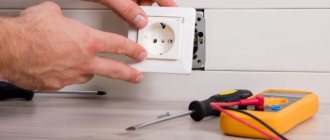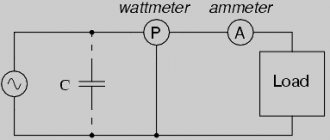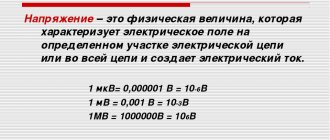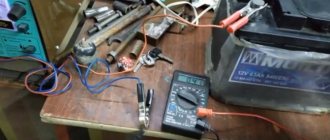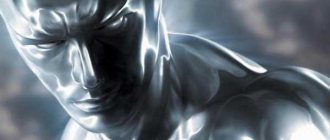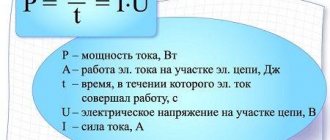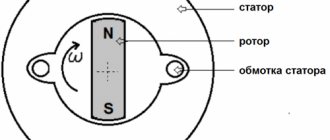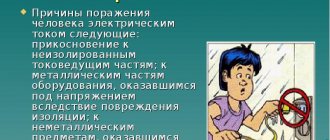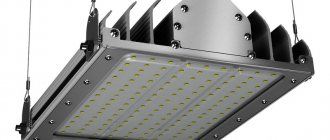Meaning of the term
The concept of electric current can be found in any physics textbook. Electric current is the ordered movement of electrically charged particles in a direction. To understand to the common man what electric current is, you should use an electrician’s dictionary. In it, the term stands for the movement of electrons through a conductor or ions through an electrolyte.
Depending on the movement of electrons or ions inside a conductor, the following types of currents are distinguished:
- constant;
- variable;
- periodic or pulsating.
Basic measurement quantities
The strength of electric current is the main indicator that electricians use in their work. The strength of the electric current depends on the amount of charge that flows through the electrical circuit over a set period of time. The greater the number of electrons flowing from one beginning of the source to the end, the greater the charge transferred by the electrons will be.
Current strength is a quantity that is measured by the ratio of the electric charge flowing through the cross section of particles in a conductor to the time of its passage. Charge is measured in coulombs, time is measured in seconds, and one unit of electrical flow is determined by the ratio of charge to time (coulombs per second) or amperes. Determination of the electric current (its strength) occurs by sequentially connecting two terminals in the electrical circuit.
When an electric current operates, the movement of charged particles is accomplished using an electric field and depends on the force of electron movement. The value on which the work of an electric current depends is called voltage and is determined by the ratio of the work of the current in a specific part of the circuit and the charge passing through the same part. The unit of measurement volts is measured by a voltmeter when two terminals of the device are connected to a circuit in parallel.
The amount of electrical resistance is directly dependent on the type of conductor used, its length and cross-section. It is measured in ohms.
Power is determined by the ratio of the work done by the movement of currents to the time when this work occurred. Power is measured in watts.
A physical quantity such as capacitance is determined by the ratio of the charge of one conductor to the potential difference between the same conductor and the neighboring one. The lower the voltage when conductors receive an electrical charge, the greater their capacity. It is measured in farads.
The amount of work done by electricity at a certain interval in the chain is found using the product of current, voltage and the time period during which the work was carried out. The latter is measured in joules. The operation of electric current is determined using a meter that connects the readings of all quantities, namely voltage, force and time.
Application of electricity
The invention of electricity is rightfully the greatest discovery, because without it modern life becomes impossible. It is found in almost every home and is used for lighting, information exchange, cooking, heating, and the functioning of household appliances. Electricity is also necessary for the movement of trams, trolleybuses, metro, and electric trains. The operation of a computer or cell phone is also impossible without electricity.
Electrical Safety Techniques
Knowledge of electrical safety rules will help prevent an emergency and protect human health and life. Since electricity tends to heat the conductor, there is always the possibility of a situation dangerous to health and life. To ensure safety at home, you must adhere to the following simple but important rules:
- Network insulation must always be in good condition to avoid overloads or the possibility of short circuits.
- Moisture should not get on electrical appliances, wires, panels, etc. Also, a humid environment provokes short circuits.
- Be sure to ground all electrical devices.
- Avoid overloading electrical wiring as there is a risk of the wires catching fire.
Safety precautions when working with electricity involve the use of rubberized gloves, mittens, mats, discharge devices, grounding devices for work areas, circuit breakers or fuses with thermal and current protection.
Experienced electricians, when there is a possibility of electric shock, work with one hand, and the other is in their pocket. In this way, the hand-to-hand circuit is interrupted in the event of an involuntary touch to the shield or other grounded equipment. If equipment connected to the network catches fire, extinguish the fire exclusively with powder or carbon dioxide extinguishers.
electrical safety
Despite the fact that electricity has become a part of our lives, we should not forget about electrical safety. High voltages are dangerous to life, and short circuits cause fires.
When performing repair work, it is necessary to strictly observe safety rules: do not work under high voltage, use protective clothing and special tools, use grounding knives, etc.
In everyday life, use only electrical equipment that is designed to work in the appropriate network. Never install bugs instead of fuses.
Remember that high-power electrolytic capacitors have a large electrical capacitance. The energy accumulated in them can cause damage even a few minutes after being disconnected from the network.
Source
Application of electric current
Electric current has many properties that allow it to be used in almost all areas of human activity. Ways to use electric current:
- a carrier of heterogeneous signals in household appliances (landline telephone, television remote control, door lock button), as well as in special communications and radio;
- energy carrier in engines, generators, batteries;
- supplier of heat energy in heating devices, furnaces, and electric welding;
- source of light energy in signaling and lighting devices;
- obtaining materials by electrolysis;
- creating sounds and music using power tools;
- electrodiagnostics in medicine, treatment with electrical stimulation.
Electricity today is the most environmentally friendly form of energy. In the modern economy, the development of the electric power industry is of planetary importance. In the future, if there is a shortage of raw materials, electricity will take a leading position as an inexhaustible source of energy.
Electric current and its uses
Now we can say with confidence that the most important achievement of mankind is the discovery of electric current and its use.
Electrical energy is of great importance, both in the life of each individual person and in the development of modern society as a whole.
Today it is difficult to imagine our life without electricity. After all, it is what lights up our homes and streets, and sets trams, trolleybuses and trains in motion.
Yes, and all the household appliances we use at home operate using electrical energy.
The operation of modern means of communication, without which we cannot imagine our lives - telephone, radio, television, the Internet - is also based on the use of electrical energy.
Electricity has settled in all spheres of human activity. Neither industry, nor agriculture, nor even science can do without electricity.
Without it, the development of cybernetics, computer and space technology would have been impossible.
But it is important to understand that the electrical energy that we use does not exist in nature in a form ready for consumption. It cannot be extracted like a mineral - oil or coal.
So where does it come from?
In order for any energy to become useful to a person, he had to learn how to handle it, which means he had to learn to convert one type of energy into another.
Humanity has coped with this difficult task. People began to receive electrical energy, which is so necessary for industrial and domestic needs, from other types of energy: mechanical, thermal, light, chemical.
Conversions of various types of energy into electrical energy occur at power plants. A device that converts any energy into electrical energy is called a source
.
People obtain the bulk of electrical energy by converting mechanical energy using special electromechanical machines.
These machines are called electric generators
.
In an electric generator, the mechanical energy of the turbine is converted into electrical energy. A turbine
is a rotating wheel of a special design. For example, in hydroelectric power plants, the turbine rotates using the energy of falling water.
In thermal power plants, the turbine rotates using the energy of steam movement.
And at wind power plants - due to wind energy.
At space stations, the source of electrical energy is photocells. They are the ones who convert solar energy into electrical energy.
In addition to stationary sources, there are portable sources of electrical energy
. These are galvanic cells, various batteries, as well as batteries made from them.
In portable sources, electrical energy is obtained through the chemical process of interaction of dissimilar metals with a special substance - an electrolyte. There are also small-sized mechanical generators that operate using the muscular strength of a person’s arms or legs. An example of a small-sized mechanical generator is a bicycle headlight generator.
Let's try to figure out how the process of transferring electrical energy occurs.
In general, the first information about electricity appeared many centuries ago and then it related to electric charges that were obtained through friction. Even in Ancient Greece, it was established that if amber is rubbed with woolen cloth, it will acquire the ability to attract light objects.
By the way, in Greek the word “amber” sounds like “electron”. “electricity” comes from this word.
.
Then people found out that many other substances have exactly the same properties. Then such substances were called electrified
.
Now we say that bodies in this state have electric charges
, and we call the bodies themselves
charged
.
So, electrical energy is transmitted using a stream of tiny charged particles.
These charged particles always arise when different substances come into close contact. In some bodies, electrical charges can move freely between different parts, but in others this is impossible. In the first case, substances are called conductors
, in the second -
dielectrics
or
insulators
.
Conductors are all metals, solutions of salts, acids, including ordinary drinking water.
Examples of insulators include glass, rubber, and various plastics.
You should know that the division of substances into conductors and dielectrics is very arbitrary. Since all substances conduct electricity to a greater or lesser extent.
In nature, there are two types of electrical charges. Conventionally, they are called positive and negative.
Around each of these charges there is an electric field, due to which like charges repel each other, and unlike charges attract each other. In the case of interaction between different substances, unlike charges will tend to move from one substance to another. The movement of these charged particles will constitute an electric current.
In general, electric shock
called the ordered (directed) movement of charged particles under the influence of an electric field.
Historically, the direction of electric current was taken to be the movement of positive charges that move from the positive pole of the source to the negative along the conductor connected to the poles.
The number of charges passing per unit time through the cross section of a conductor is called current strength
.
This dependence is expressed by the following formula: , where is the current strength, is the number of charges, is time.
The unit of current is called the ampere.
, in honor of the French scientist Andre Ampère.
All electrical devices are supplied with constant
and
alternating current
.
Electric current, the direction and value of which does not change over time, is called constant
.
And an electric current, the direction and value of which can change periodically, is called variable
.
Most electrical devices are powered by alternating current.
Now let's look at the features of the flow of electric current in various environments and its application.
So, when considering the issue of the flow of electric current, it is necessary to take into account the presence of various current carriers - elementary charges - characteristic of a given physical state of a substance. The substance itself can be solid, liquid or gas.
In metal conductors, current is generated due to the movement of electrons having a negative charge. In general, all metals are current conductors. The application of current in metals is used to transmit electricity over a distance.
Among liquids, only electrolytes - solutions of salts, acids and alkalis - conduct electric current. The passage of direct electric current through liquid media is accompanied by chemical reactions. This property is widely used in batteries, in electrometallurgy for the production of aluminum and bauxite, as well as in the electrochemical processing of materials and the purification of metals from impurities.
An electric current in a gaseous medium causes the gas to glow. Fluorescent lamps, lasers, and spotlights operate on the basis of this phenomenon.
Devices that convert electrical energy into other types of energy - light, heat, mechanical and chemical energy - are called receivers
or
consumers of electrical energy
, and in electrical engineering -
load
.
In order for an electrical device (or load) to work, it must be connected to the poles of a current source. In practice, the source and load are often connected using additional conductors; in everyday life and electrical engineering they are called wires.
What we just talked about: the source of electrical energy, the load and the connecting wires - all together this is called an electrical circuit
.
Lesson summary
In this lesson we talked about electric current and its uses. We looked at various sources of electricity. We figured out how the process of transferring electrical energy occurs. We also looked at the features of the flow of electric current in various environments and its application.
